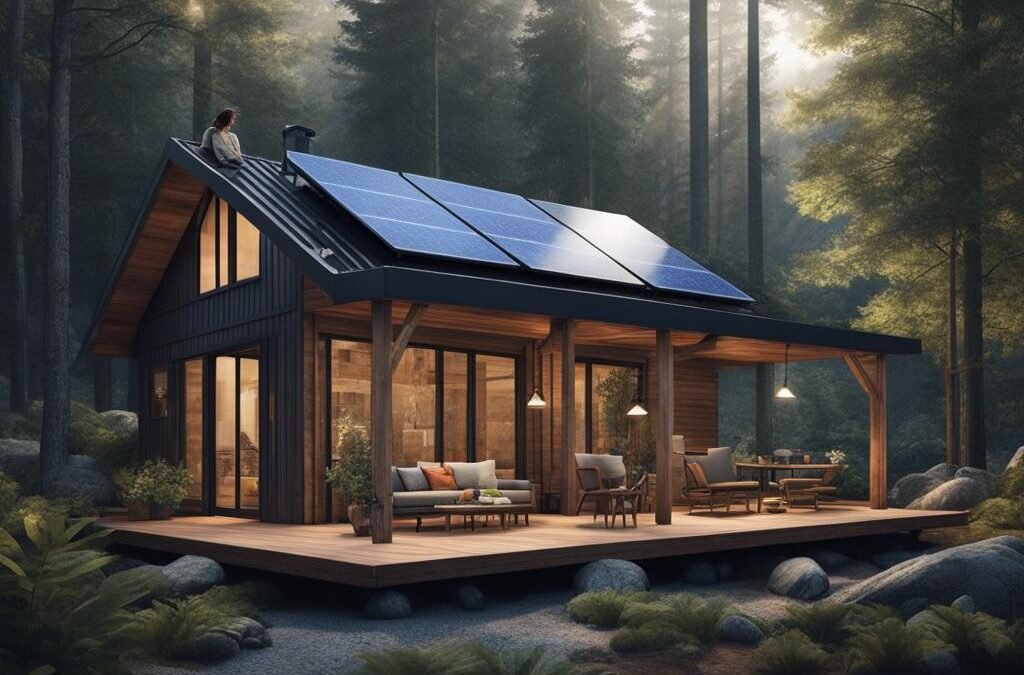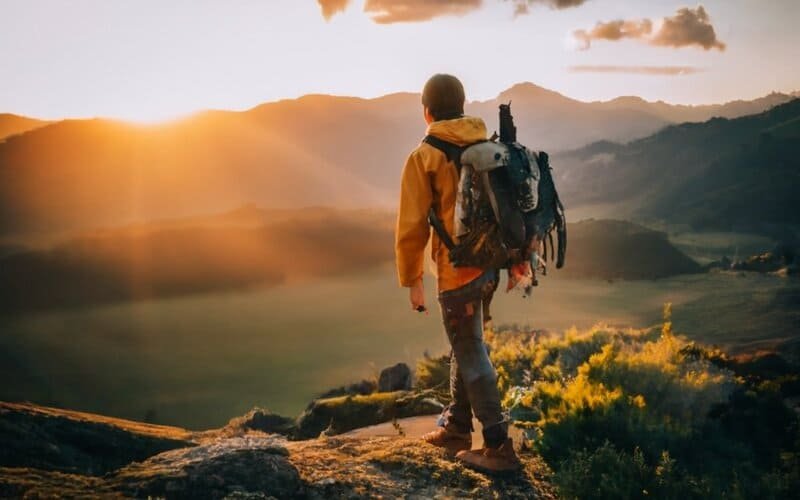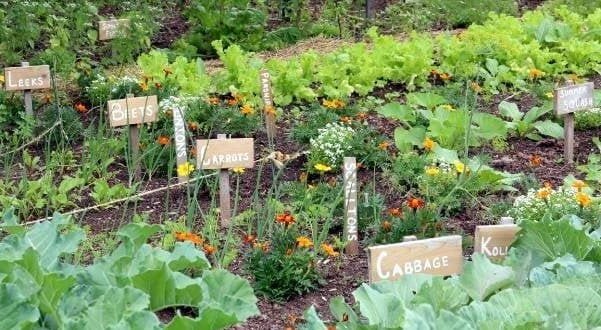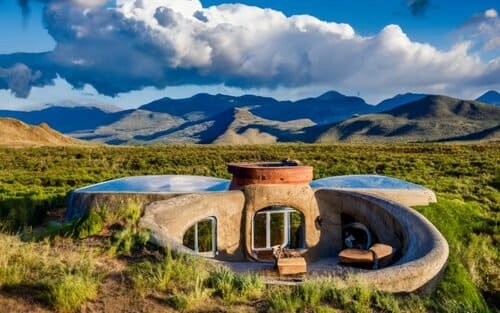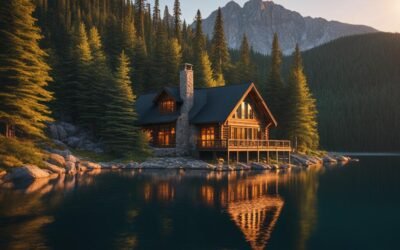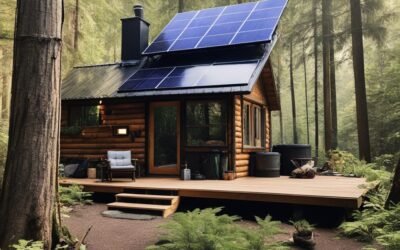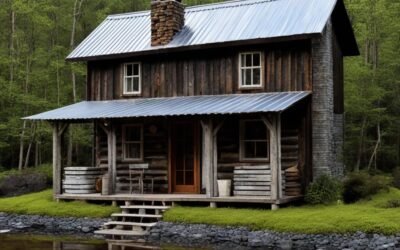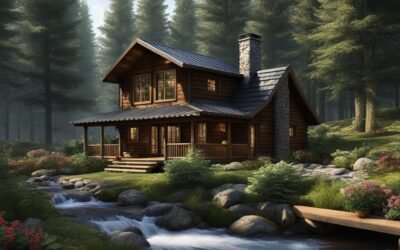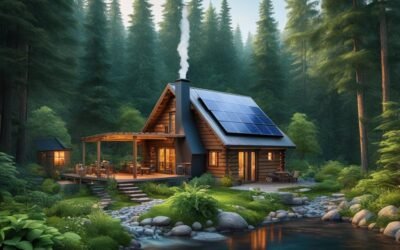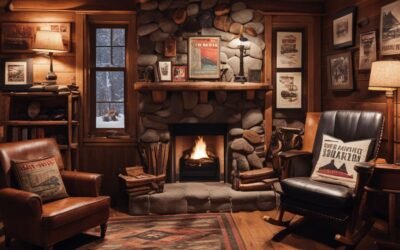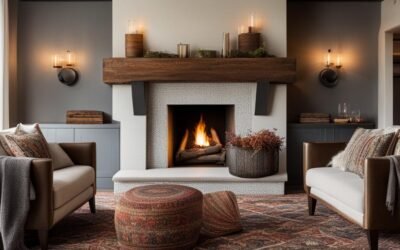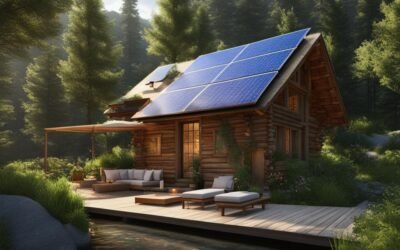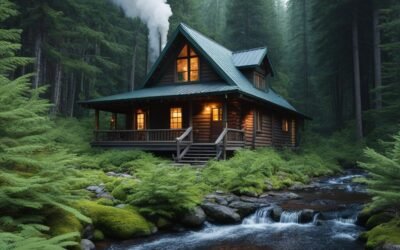Building an off-grid cabin is a thrilling adventure that allows me to disconnect from the grid and create a sustainable retreat in a natural setting. Whether I am seeking a weekend getaway or a permanent residence, constructing an off-grid cabin requires meticulous planning, resourcefulness, and a commitment to an eco-friendly lifestyle.
In this guide, I will outline the key steps involved in building an off-grid cabin. From the initial planning stage to selecting the right materials and incorporating sustainable practices, I will share my insights and tips for a successful off-grid cabin construction project.
Key Takeaways:
- Building an off-grid cabin offers a sustainable and self-sufficient living option in a natural setting.
- Thorough planning and careful consideration of location, materials, and resources are crucial.
- Choosing the right off-grid power system, water supply, and waste management solutions ensures a self-sustainable cabin.
- Efficient heating, cooling, and insulation systems contribute to energy-saving and comfortable living.
- Building an off-grid cabin allows me to enjoy the serenity of nature while taking steps towards a more sustainable lifestyle.
Planning Your Off-Grid Cabin
When building an off-grid cabin, it’s important to carefully plan every aspect of the project. Start by choosing the ideal location that offers accessibility, sunlight, water supplies, and proximity to facilities. Consider the laws and regulations while keeping in mind the environmental impact. Make a thorough plan for the cabin, considering power and water accessibility, waste disposal, and insulation. Take into account the price range and consider value for money when selecting materials and tools for construction.
One key aspect of planning your off-grid cabin is designing the off-grid power system. This system will provide you with the necessary energy to power your cabin when disconnected from the grid. Consider the different options available, such as solar power, wind power, or a combination of renewable energy sources. Calculate your power requirements based on your anticipated energy usage to determine the size and capacity of the solar panels, batteries, and inverters needed for your system. Investing in a reliable and efficient off-grid power system is crucial for a self-sufficient off-grid cabin.
Another important consideration in planning your off-grid cabin is the design itself. Off-grid cabin design should prioritize energy efficiency, sustainability, and practicality. Choose a design that maximizes natural lighting and airflow to reduce the need for artificial lighting and cooling systems. Optimize insulation to maintain comfortable temperatures inside the cabin and minimize energy usage for heating and cooling. Consider using reclaimed or locally-sourced materials to minimize environmental impact and embrace a low-cost, eco-friendly approach to construction.
In addition to power and design considerations, think about the water supply and waste disposal for your off-grid cabin. Determine the most suitable water supply option based on your location, such as wells, springs, or rainwater harvesting systems. Install a water filtration system to ensure access to clean drinking water. For waste disposal, consider eco-friendly alternatives like composting toilets to minimize water usage and create nutrient-rich compost for your garden. Implement a greywater system to recycle and reuse wastewater for non-potable purposes, further reducing your environmental footprint.
By thoroughly planning your off-grid cabin, considering power systems, sustainable design, water supply, and waste management, you can create a low-cost, self-sufficient, and eco-friendly retreat that aligns with your values and allows you to live harmoniously with nature.
Comparison of Off-Grid Cabin Power Systems
| Power System | Solar Panels | Battery Capacity | Inverter | Price |
|————————|————–|——————|————|———-|
| BLUETTI AC200MAX | 3 | 2152 Wh | 1500W | $1799.00 |
| BLUETTI AC300MAX | 4 | 3072 Wh | 2000W | $2549.00 |
| BLUETTI EP500Pro | 6 | 5104 Wh | 3000W | $3199.00 |
When choosing an off-grid power system, consider factors such as the power output, storage capacity, and price. The table above provides a comparison of three popular off-grid power systems. The BLUETTI AC200MAX offers a compact design with a sufficient battery capacity and power output for small to medium-sized cabins. The BLUETTI AC300MAX provides a higher battery capacity and power output, suitable for larger cabins. The BLUETTI EP500Pro offers the maximum battery capacity and power output, ideal for cabins with high energy demands.
Choosing an Off-Grid Solar System
 Solar energy is a crucial component of off-grid living, providing renewable and sustainable power for cabins and homes. When selecting an off-grid solar system, it’s essential to consider your power needs, available space, and budget. Here are three popular options:
Solar energy is a crucial component of off-grid living, providing renewable and sustainable power for cabins and homes. When selecting an off-grid solar system, it’s essential to consider your power needs, available space, and budget. Here are three popular options:
1. BLUETTI AC200MAX + 2*B230 + 3*PV200
This off-grid solar power system offers modularity and expandability, making it suitable for various off-grid cabin sizes. With its high battery capacity and pure sine wave inverter, the BLUETTI AC200MAX + 2*B230 + 3*PV200 provides reliable and efficient power for your off-grid needs.
2. BLUETTI 2*AC300 + 4*B300 + 1*P030A + 6*PV200
If you require a more extensive power supply, the BLUETTI 2*AC300 + 4*B300 + 1*P030A + 6*PV200 system is an excellent choice. With multiple AC outlets, a robust battery capacity, and efficient solar panels, it can meet the energy demands of larger off-grid cabins.
3. BLUETTI EP500Pro Solar Power Station
The BLUETTI EP500Pro Solar Power Station is a versatile solution for off-grid power needs. With its compact design and portability, this system is suitable for smaller cabins or those that require power on the go. It offers a range of features, including a foldable solar panel, MPPT charging, and multiple AC and DC output options.
When choosing an off-grid solar system, consider factors such as your power usage, location, and long-term sustainability goals. Selecting the right system can provide you with reliable, clean, and cost-effective power for your off-grid living.
Water and Sanitation of Cabins
 A reliable water source and proper sanitation arrangements are essential for off-grid living. When building an off-grid cabin, it is crucial to consider the off-grid water supply and off-grid waste management systems that will sustain your daily needs while minimizing your environmental impact.
A reliable water source and proper sanitation arrangements are essential for off-grid living. When building an off-grid cabin, it is crucial to consider the off-grid water supply and off-grid waste management systems that will sustain your daily needs while minimizing your environmental impact.
One of the first steps in ensuring a stable water source is to select a method that aligns with your location and needs. Popular options include:
- Wells: Drilling a well can provide a consistent water supply, but it may require professional assistance and investment.
- Springs: If your property has a natural spring, it can provide a reliable source of water. However, it is important to test the water quality and take necessary precautions.
- Rainwater Collection Systems: Harvesting rainwater can be a sustainable solution, particularly in areas with ample rainfall. Install proper gutters and storage tanks to collect and store rainwater.
Once you have established a water source, it is essential to install a robust filtration system to ensure clean drinking water. Consider using a combination of sediment filters, activated carbon filters, and UV sterilizers to remove impurities and pathogens.
Composting toilets are an environmentally friendly and water-saving option for waste management in off-grid cabins. These systems convert human waste into nutrient-rich compost through natural decomposition, eliminating the need for water-based flushing systems or septic tanks. Composting toilets are odorless, low-maintenance, and contribute to sustainable waste management.
To further reduce water usage, implement a greywater collection and filtration system. Greywater refers to wastewater from sinks, showers, and laundry, which can be reused for non-potable purposes such as flushing the toilet or watering plants. Install a separate plumbing system to divert and filter greywater, ensuring its safe and sustainable reuse.
Designing an effective plumbing system is essential to supply water throughout the cabin. Consider using high-quality, durable materials that minimize the risk of leaks and promote water efficiency. Install shut-off valves and pressure regulators to control the water flow and reduce wastage.
Benefits of a Sustainable Plumbing System:
“A sustainable plumbing system ensures efficient water usage and proper waste management, leading to reduced environmental impact and a more self-sufficient off-grid lifestyle.”
| Benefits | Features |
|---|---|
| Water Conservation | – Low-flow fixtures – Greywater reuse |
| Energy Efficiency | – Insulated pipes – On-demand water heaters |
| Reduced Environmental Impact | – Composting toilets – Proper waste filtration |
| Sustainable Lifestyle | – Self-sufficient water supply – Minimal reliance on external systems |
Heating, Cooling, and Insulation of Cabins
 Maintaining a comfortable temperature in an off-grid cabin is essential for a cozy and enjoyable living experience. To achieve this, it’s crucial to have efficient heating and cooling systems in place. Here are some tips and strategies for effective temperature control:
Maintaining a comfortable temperature in an off-grid cabin is essential for a cozy and enjoyable living experience. To achieve this, it’s crucial to have efficient heating and cooling systems in place. Here are some tips and strategies for effective temperature control:
Heating Options
- Propane Heaters: Propane heaters are a popular choice for off-grid cabin heating due to their efficiency and affordability. They provide consistent warmth during the colder months and can be easily regulated.
- Sun Heating: Take advantage of the sun’s heat by strategically positioning windows and using thermal mass materials, such as tile or stone, to absorb and radiate warmth throughout the cabin.
- Wood Stoves: A classic and sustainable option, wood stoves provide both heat and a cozy ambiance. They can be fueled with firewood sourced locally or sustainably.
Cooling Strategies
- Open Windows: Allow for cross ventilation by strategically opening windows to create a natural breeze, especially during cooler times of the day.
- Shade from Trees: The natural shade provided by trees can significantly reduce the heat inside the cabin. Consider planting trees strategically to provide shade without blocking essential sunlight.
- Reflective Roofing Materials: Use light-colored or reflective roofing materials to minimize the absorption of heat from the sun, which helps keep the cabin cooler during hot summer days.
Energy-Efficient Insulation
Investing in energy-efficient insulation is crucial for maintaining a consistent temperature inside the cabin and minimizing energy consumption. High-quality insulation materials for walls, roofs, and floors help regulate temperatures year-round, reducing the need for excessive heating or cooling. Popular insulation options include:
| Insulation Material | Benefits |
|---|---|
| 1. Fiberglass Insulation | Excellent thermal performance, highly durable, and resistant to moisture |
| 2. Cellulose Insulation | Eco-friendly, made from recycled paper, and provides excellent soundproofing |
| 3. Spray Foam Insulation | Provides a seamless air barrier, seals gaps, and offers superior insulation properties |
By combining efficient heating and cooling systems with proper insulation, you can create a comfortable and sustainable living space in your off-grid cabin. These measures not only enhance your comfort but also contribute to reduced energy consumption and a more eco-friendly lifestyle.
Conclusion
Building an off-grid cabin is a challenging but rewarding journey. Throughout this guide, I have explored the key steps involved in constructing a sustainable and eco-friendly retreat in nature. By carefully planning the location, design, and resources, you can create a self-sufficient off-grid cabin that allows you to disconnect from the grid and embrace a more sustainable lifestyle.
One of the most crucial aspects of off-grid cabin construction is incorporating sustainable practices. From power generation to water supply, waste management to temperature control, there are various eco-friendly solutions available. Utilizing renewable energy sources like solar power, implementing efficient water conservation methods, and investing in proper insulation can greatly reduce your environmental impact while promoting a more sustainable way of living.
It’s important to consider the cost considerations, legal and regulatory aspects, and the adjustment to a sustainable lifestyle. While building an off-grid cabin requires careful planning and resourcefulness, the benefits of disconnecting from the grid and living in harmony with nature make it all worthwhile. Create your own sustainable retreat, embrace the tranquility of off-grid living, and leave a positive impact on the environment.
FAQ
What are the key steps involved in building an off-grid cabin?
The key steps involved in building an off-grid cabin include carefully planning the location, considering accessibility and proximity to facilities, designing the cabin for power and water accessibility, waste disposal, and insulation, selecting materials and tools within your budget, and complying with laws and regulations.
What are some options for off-grid solar power systems?
Some options for off-grid solar power systems include the BLUETTI AC200MAX + 2*B230 + 3*PV200, BLUETTI 2*AC300 + 4*B300 + 1*P030A + 6*PV200, and BLUETTI EP500Pro Solar Power Station. These systems offer modular and expandable capabilities, with various battery capacities and pure sine wave inverters, making them suitable for different off-grid cabin sizes and power needs.
What are some water and sanitation considerations for off-grid cabins?
For water supply, stable sources like wells, springs, or rainwater collection systems are ideal, supplemented with a robust filtration system for clean drinking water. Composting toilets are a good option for water-saving and environmentally friendly waste management. Implementing a greywater collection and filtration system allows for the reuse of wastewater for flushing toilets or watering plants. Designing an effective plumbing system also ensures water supply throughout the cabin.
How can I maintain a comfortable temperature in an off-grid cabin?
There are several strategies for maintaining a comfortable temperature in an off-grid cabin. Propane heaters, sun heating, and wood stoves can be used for warmth during colder months. Open windows, shade from trees, and reflective roofing materials help with cooling in summers. Investing in high-quality insulation for walls, roofs, and floors ensures consistent temperatures and energy efficiency.
What are some considerations when building an off-grid cabin?
When building an off-grid cabin, it’s important to consider cost, legal and regulatory requirements, and the adjustment to a sustainable lifestyle. Careful planning of the location, design, and resources is crucial, along with incorporating sustainable practices for power generation, water supply, waste management, and temperature control.

